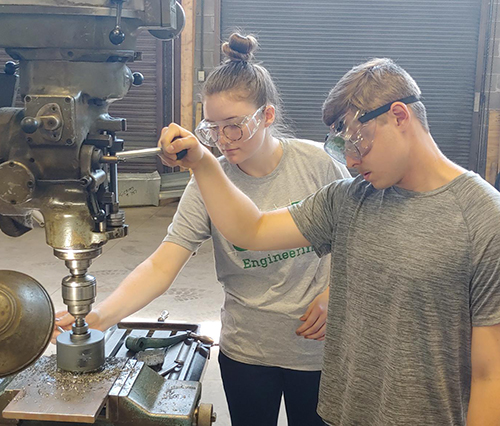Three pairs of undergraduates in the Department of Biomedical Engineering recently completed a unique research and development program sponsored by the National Institutes of Health (NIH). Over an eight-week period that ended in late July, six rising juniors engaged in team-based projects that led them through the process of medical-device development—from identifying a challenge to designing and building a prototype.
The six fellows—Jade Buston, Dylan Cothron, Hunter Goffinett, Brianna Green, Annabel Johnson and Georgianna Khong—were selected in a competitive process and were chosen for their “intellectual promise, curiosity, and motivation.” Each student was awarded $3,000 from the NIH for participating in the program, plus an additional $250 for prototyping expenses.
The program (nicknamed “I2D2” for Immersive/Innovation, Design/Development) was divided into distinct stages, with students spending a minimum of 30 hours per week working on their projects with the goal of improving outcomes for hospitalized patients and patients in rehabilitation. To do this, they were required to shadow clinicians from the UAB Department of Surgery and/or physical therapists and patients at Lakeshore Foundation to come up with ideas for their projects. Next steps were to perform background research and finally to engage in design and prototyping.
“The goal here was for these students to experience the entire process of research and development,” said Program Director Alan Eberhardt, Ph.D. “To do that, they had to meet with the doctors, therapists, and patients to develop empathy for the real-world challenges they deal with in their day-to-day roles.”
Once students had an idea of a product they would like to develop, they had to conduct market analyses and research existing intellectual property and regulatory issues. For the final step, two of the teams worked with Steve Thompson in the UAB Materials Processing and Applications Development facility to fabricate working prototypes.
Two teams worked on projects with UAB surgeons. Their finished prototypes included proof of concept for a steerable endoscope, a lens-cleaning device for endoscopes and a device for rapidly drying surgical glue. The third team worked with clinicians and patients at the Lakeshore Foundation to enhance a walking stick and to help a person with spinal cord injury to rise out of bed.
“These were some ambitious projects for students who have only had two years of engineering coursework,” Eberhardt said. “Compare this to our capstone senior design course where students have two semesters to develop a prototype, and you realize how big of a task these students took on. They all did a remarkable job.”
Because of the time and budget restraints, the prototypes students created are still in the very early stages of development, but Eberhardt says all have potential to become marketable devices. “In only eight weeks, these students went through a full R&D process,” Eberhardt said. “Not just design—but all things related to medical device development in the real world. My hope is that some of these ideas can be picked up by future senior design or Project Lab teams to move these prototypes towards commercially viable products.”
